Table of contents
- Laverda 650/750 The classic from Laverda as a used one
- The history of the two-cylinder
- In detail, data
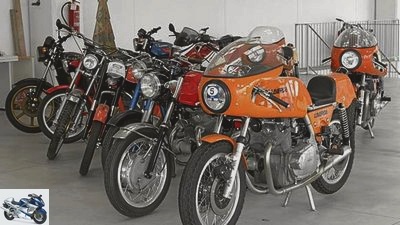
Schermer
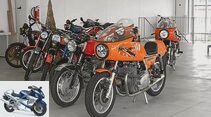
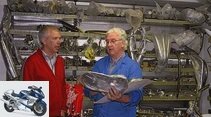
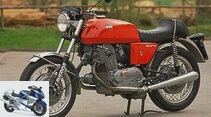

21 pictures
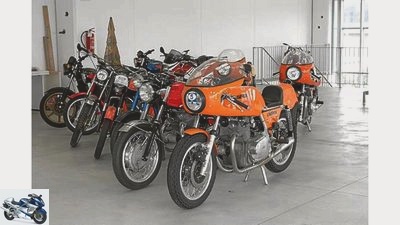
Schermer
1/21
The Laverda as a used one. You can find out what to consider when buying in this photo show.
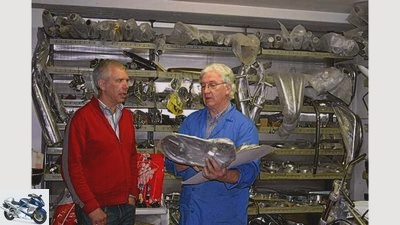
Schermer
2/21
Has (almost) everything and knows a lot more: Laverda jack-of-all-trades Andrighetto (right).

Schermer
3/21
Drum brakes, Japanese instruments, hump seat: the 750 SF1 from 1973.

Schermer
4/21
The Laverda 750 (type 750 SF2).

Schermer
5/21
Are the fittings working? The switch units are standard Japanese goods from the 1970s; they can even be dismantled for repairs. Here the turn signal switch was temporarily repaired with a screw.
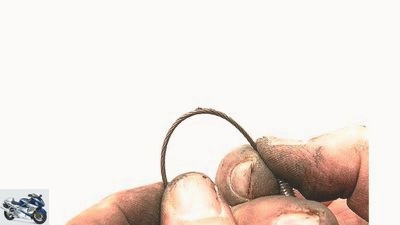
Schermer
6/21
Slowly operate the throttle, clutch and brake: Do the cables run smoothly in their covers all the way? Has a wire of the inner cable set up, does it rub well? Then a new train is due.

Schermer
7/21
When machines with disc brakes are idle for a long time, the brake pistons are usually corroded, and often their holes in the caliper too. You can have that repaired by a specialist. But new parts are better because they are safer.
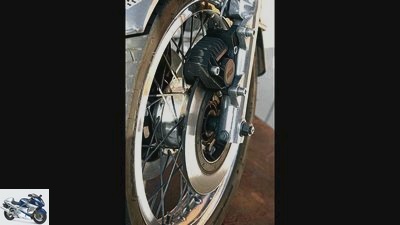
Schermer
8/21
Checking the surface of the brake disc is a matter of eyes and fingers: The disc should be as smooth as possible, should not have any noticeable rust scars and show little or no wear marks inside or out.
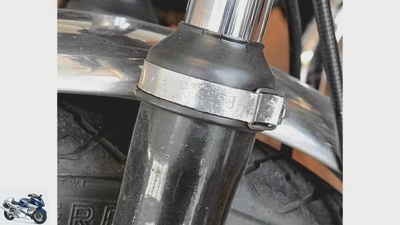
Schermer
9/21
Check the standpipes carefully, there must not be any pressure marks, sanding marks, deep stone chip scars or even chipped chrome. If the dust caps are cracked, as here, be sure to install new parts.
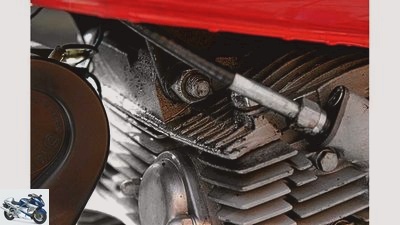
Schermer
10/21
With heavily oily engines like here in the picture, the head and cylinder have to be lowered and new seals installed. A labor-intensive undertaking for the Laverda Twins because the engine has to be removed.
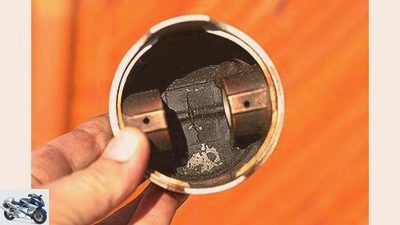
Schermer
11/21
This piston has a crack, but it has healed itself. Not a good sign: the engine got partially too hot, which caused the crack, but welded it again a short time later. Exchange!
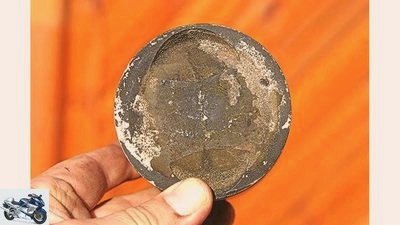
Schermer
12/21
This piston has a crack, but it has healed itself. Not a good sign: the engine got partially too hot, which caused the crack, but welded it again a short time later. Exchange!
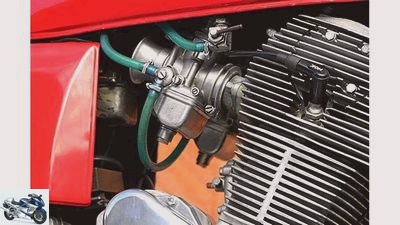
Schermer
13/21
A drooling fuel tap can usually be repaired or replaced for little money. Petrol hoses become hard and brittle over time. They should be renewed regularly and secured with clamps.
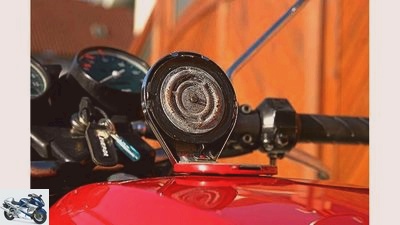
Schermer
14/21
An absolute MUST for every visit – not only at Laverdas – is the deep look into the tank. Shine a slim flashlight into the tank. If you see rust, expensive and time-consuming refurbishment of the tank is inevitable.
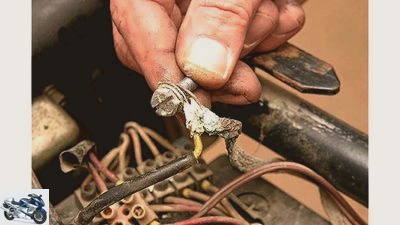
Schermer
15/21
One of the biggest weaknesses of the Laverda Twins! Laypeople are overwhelmed with the vulnerable electrical system. Here are two typical examples: on the left a corroded battery connection, on the right an original ground connection.
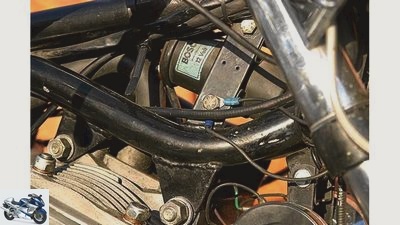
Schermer
16/21
One of the greatest weaknesses of the Laverda Twins! Laypeople are overwhelmed with the vulnerable electrical system. Here are two typical examples: on the left a corroded battery connection, on the right an original ground connection.
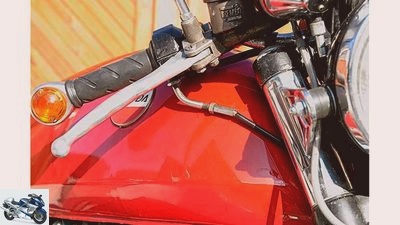
Schermer
17/21
Swivel the handlebar all the way to the right and left as far as it will go. Sufficient space must be left between the fittings and the tank. It is missing here. The cause is often a bent steering stop as a result of a fall.
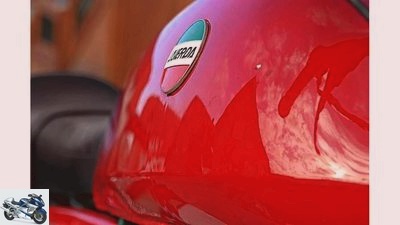
Schermer
18/21
Look closely: on this Laverda you can see a lacquer nose, also known as “Trieler”, under the tank emblem. It is an unmistakable sign of bad repainting. Take this into account when negotiating prices!
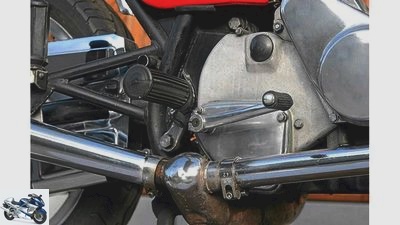
Schermer
19/21
Full concentration required: gear lever on the right, brake lever on the left.
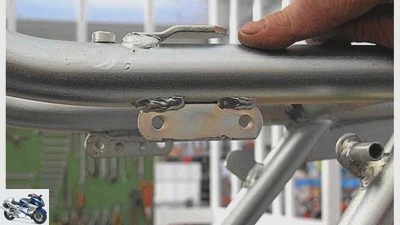
Schermer
20/21
Only real with a cutting edge: this is how the expert recognizes a true SFC.
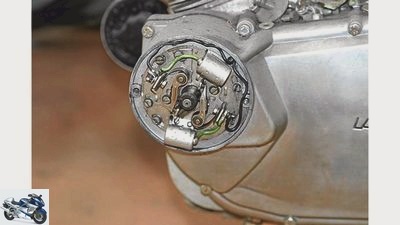
Schermer
21/21
Care case: the contact ignition, ideally replace with a contactless one.
counselor
Used purchase
Laverda 650/750 purchase advice
Laverda 650/750
The classic from Laverda as a used one
Content of
Solidly built like a tractor, but sensitive like an Italian diva – a Laverda makes no secret of its origin. You still want one of the 750s? Then strike if you can find one. But please do not be rash. Because a Laverda twin does not necessarily meet the expectations of today’s buyers.
Franz Josef Schermer
13/01/2012
It happened. Simply that way. Helmut stumbled across a 750 Laverda, now it’s in his garage. Knowing full well that at least one more sum will flow into “the good used one” for 3000 euros. To restore them to their original state. And to make it a little better, that is, more reliable. So it goes to Breganze first, spare parts are needed.
Riccardo Oro is our first address there. He is with Laverda grew up, his father worked in the experiment for many decades. Oro used to have his little shop on Breganzer Hauptstrasse, now it is in an industrial area in front of Breganze, within sight of the old Laverda factory. Three years ago he moved his workshop, warehouse and his own motorcycles into an 800 square meter industrial building. Some of his machines and Laverdas from customers, which he is supposed to prepare, are on the ground floor. They are in all possible states of conservation. An “economic total loss” catches our eye in particular. “The owner had a serious accident with it 35 years ago, and it has been standing in the shed ever since,” says Riccardo with a grin. “He recently delivered it with the order to rebuild it. But that will take a while. ”The impact must have been severe: the hub of the front cast wheel is broken, as is the brake disc and the front axle.
Oro is currently setting up a small museum on the upper floor. There are all sorts of Laverdas, from the first 75 four-stroke single-cylinder from the early 1950s to a 200 two-cylinder to the 750 two-cylinder. Among them are some 750 SFC in top condition. Even three-cylinder, whether 1000 or 1200, are represented in all states of preservation, as well as the rare two-stroke Laverdas with Zundapp engines. He owns more than 100 copies – no wonder that the building is secured by cameras all around.
Riccardo Oro stocks spare parts for all models, the focus is of course on the 750 two-cylinder and 1000/1200 three-cylinder. Brand new frames hang on the wall wrapped in oiled paper, and in the back of the large shelves are telescopic forks, wheels, brakes, swing arms and struts. Many spare parts, especially for the engine, are made from old parts and are then considered “used, but technically as good as new”. What new parts no longer existed back then is reproduced: footrest rubbers, hand levers, Bowden cables, switches, gears and shafts for transmissions, clutch parts and primary drive chains are also available as new parts, as are carburettors and their innards.
The prices are real: gas cable 28 euros, speedometer cable 15 euros, two Laverda tank emblems 40 euros, a seal for the primary cover 9 euros – well, at the end of the day there are 599 euros on the bill. With the good feeling that we have got everything we wanted, we set off on Via San Felice (“Street of the Holy Happy”) in the Breganz suburb of Maragnole.
Giuseppe Andrighetto lives and works there. On the ground floor of his small house, the workshop and parts warehouse the size of a four-compartment garage are located. The rooms are the focal point for Laverda fans from all over the world who either just visit the nice older Giuseppe for a chat or need spare parts: Everything has its proper place here, too, the own machines are protected from dust under transparent tarpaulins, some customer machines are ready to be picked up before. Giuseppe is a living legend among Laverda fans: He not only assembled the 750 SFC, but knows (almost) all of the almost 550 Production Racers built. He was also an organizer and mechanic in many long-distance races that were driven with the 750 and 1000 cc. In the late 1970s, he developed the long-distance racing tubular space frame for the 1000cc three-cylinder and built 15 of them. If someone wants such a frame, they build one and the tank with it; You can use it to assemble a long-distance Laverda as an “original replica”.
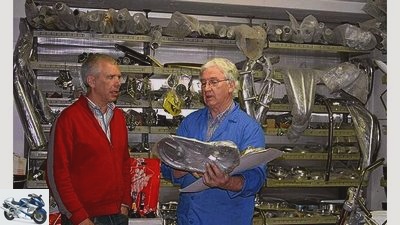
Schermer
Has (almost) everything and knows a lot more: Laverda jack-of-all-trades Andrighetto (right).
In his youth, Giuseppe was known by Laverda as “Jack of all trades”. Was at all the major racetracks in Europe and Africa, where he was in charge of the technical support for the 750 cc government machines delivered to Ghaddafi’s police in the late 1970s and early 1980s. In Laverda’s testing department, he organized sports homologations and also provided importers with all the technical data required for approval.
When asked about the market situation for the 750 Laverdas, Andrighetto and Oro answer in unison: “If you want a Laverda 750, then buy one – if you can find one! Because the market is tight, there are now real enthusiast machines. ”Both warn:“ Be careful with Laverda offers in Italy, there are a lot of overpriced junk boxes! ”The recommendation of the specialists: give yourself time when buying. You should also know which model it should be. Laverda laypeople advise both to first find out in forums, at brand meetings and among specialists what to expect when you buy a Laverda 750: They often do not meet the high expectations that today’s customers of Italian classics have of their Italian Make your dream motorcycle. We’ll tell you why on the following pages.
Contact
Riccardo Oro
Via dell Industria, 1
I-36042 Breganze (VI)
Telephone and fax 00 39/0 445 873 005
Giuseppe Andrighetto
Via San Felice
I-36042 Maragnole (VI)
Telephone 0039/0 445 850 259
The history of the two-cylinder
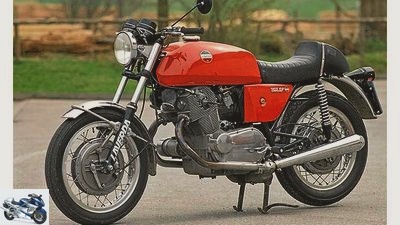
Schermer
Drum brakes, Japanese instruments, hump seat: the 750 SF1 from 1973.
To understand why the Laverda Twins were so massive, you have to look back a long way. Until the mid-1960s.
Even then there were big motorcycles. Bikes with 500, 600 or even 650 cubic centimeters, which have been known as “thunder bolts” with outputs of around 50 hp and a top speed of almost 180 km / h. For example the BMW boxer with 500 and 600 cm³. AJS, BSA, Norton and Triumph built their long-stroke twin-cylinder models in England, and Guzzi built the V7 models in Italy. The 750 V2 Ducatis came later, MVs were simply too expensive, Harleys were exotic at the time, and the Japanese were just arriving.
Kawasaki, Suzuki and Yamaha offered rather small machines between 90 and 350 cm³ at the time. Only Honda had dared to jump into the “big class” with the CB 450: In 1965, Soichiro Honda set the first benchmark with the two-cylinder, with which he indicated that he was about to knock out the ever-oily and constantly unreliable Englishmen as soon as possible.
And it was precisely at this time that the family company Laverda began developing a “large” machine. Money was available because the parent company “Pietro Laverda Agricole” had been building agricultural machinery for ages, while Pietro’s grandson Francesco founded the Moto Laverda vehicle company in 1947. The idea for the “Laverda Big Bike” came from Laverda sons Massimo (he died in 2005) and Piero, then in their mid-twenties and enthusiastic motorcyclists on BMW R 69 S and Vincent Black Shadow. Her father’s company had been building motorcycles since 1950, but produced rather small items between 75 and 200 cubic centimeters, which were only partially suitable for showing off on Via Principale del Sol (“main street to the sun”) in the direction of the espresso bar. The little Laverdas sniffed racing air at long-distance road races such as “Milano-Taranto”, which are popular in Italy. There they fought bravely and even won class wins.
The new, large Laverda was supposed to form a synthesis between European motorcycle tradition and the belief in progress that came from Japan of all places in the 1960s. This was exactly what the new Laverda engine could see, because the cylinder and head were similar to the Honda models CB 72 and CB 77, which had conquered the market for “small” machines around the world in the early 1960s.
Massimo Laverda, the older of the two Laverda brothers, had turned his vision into a touring sports motorcycle, making the 650 exactly in line with the spirit of the times. A classic “naked bike”, as we speak today. A short time later, Norton came up with the 750 Fastback. Laverda therefore bored the 650 cc engine to 750 cm³, a second prototype was presented and then went into series production. In keeping with the “spirit of the times”, Massimo Laverda and his chief designer Luciano Zen (he died in 1983) made the highest demands on stability and reliability. That’s why the new 750 was not a filigree lightweight, but quite a chunk: the engine alone, weighing around 85 kilograms, is a massive part, which is not inferior to the tubular frame chassis (later open at the bottom) with the 32 mm frame tubes. With a full tank, the 750 weighed a hefty 240 kilograms.
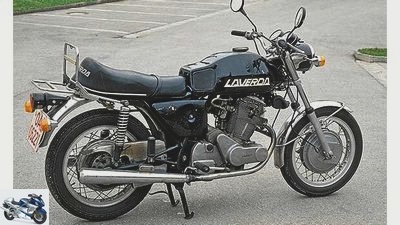
Schermer
Narrow and low tank at the back, high touring handlebars: the 750 GT from 1970.
On the other hand, buyer interest was not quite as lush. Whereby Laverda 650 and 750 Twins produced around 14,500 between 1968 and 1978 are not that bad at all. In addition, there are another 550 of the Production Racer 750 SFC (SFC means “Super Freni Competizione”), always painted in orange. SFCs were built in three blocks: The first came in 1971, they had drum brakes and were primarily intended for the Italian market. The second batch came in 1973 with disc brakes, the last in 1975 also had contactless, electronic ignition. Some were also delivered with the five-spoke cast wheels of the “normal” 750s.
But their heyday was over early in the 70s, because Paul Smart and Bruno Spaggiari had clinched the legendary double victory in their Ducati 750 SS Desmo in the 200-mile race in Imola in 1972 and Moto Guzzi had a hot iron in the fire with the V7 Sport that was well received in the market. The “normal” Laverda 750 road models achieved notable success in tests by the specialist magazines, but they weren’t really “really good”: better than the English, of course, and above all more reliable. But in comparison to the Japanese attacking with ever new and more powerful and more powerful models, the 750 Laverdas did not arrive after a short time.
This was mainly due to the fact that many things were not well resolved constructively. The engine vibrated miserably because the manufacturing quality and balance of the heavy crankshaft fluctuated greatly. Even if the ignition was not set exactly (!) The Laverda-Twin shook like an unwilling harvester. And of course the synchronization of the carburettors also had to be set correctly. The undercarriage was reasonably stable, but it was sprung as hard as a board, regardless of whether Marzocchi or Ceriani suspension elements were installed. In addition, the high center of gravity and the heavy top-heaviness had a negative impact on driving behavior. In addition, the drum brakes designed and manufactured by Laverda themselves were called “SF” for “Super Freni” (“Super Brake”), but were actually fading-intensive soft brake cans, while other manufacturers had long been offering disc brakes.
Further points of criticism were the difficult-to-use clutch, a hard shift on the “wrong” side, because it was on the right, and the ergonomically unsatisfactory switch units on the handlebars. The electrics continued to be a real disaster. In the first models, all the cables came together in the connector strips inside the headlight, later under the tank on the right-hand side of the upper frame tube, and at the very end under the battery box. Because of this, many rides in the rain unfortunately ended under the next motorway bridge…
A real shot in the oven was the exhaust manifold connecting pipe with a front silencer, which ran under the engine from 1973, because it touched down and grinded through even at a moderate angle. If there were bumps, it quickly levered the driver out of the saddle; usually the driver and the machine flew off the road together.
So it happened as it had to: Under the pressure of the competition, the Laverda two-cylinder was soon pushed into the corner of the “real men’s motorcycle”, which earned its pilots the reputation of the “strong man with the iron hand”, but more in terms of sales What was a hindrance: Who wants to struggle with the pursuit of his hobby??
The SFC models occupy a special position, as there are quite a few legends around them. The fact is that factory-installed SFC 750s have won some long-distance races or at least made it to the front. The first factory racing machines from 1969 were nothing more than specially prepared series 750s, which had been brought to almost 70 hp with the usual tuning measures: polished crankshaft, larger valves, “sharp” camshaft, higher compression, larger carburettors (36er Dellorto SSI) and a brutally loud 2-in-1 exhaust were sufficient for long-distance races. Laverda certainly achieved its most famous victory with its two-cylinder engines in 1971 at the 24 Hours of Oss in Holland, when three Laverda driver teams took the podium.
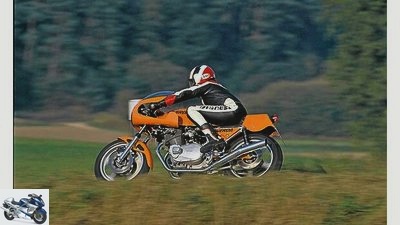
Schermer
Orange athletes: the 750 SFC, here with an approved exhaust.
The race took place on a narrow, miserably dangerous course that would not even be approved for a bicycle race today: a straight about 1.2 kilometers in length, the rest of the course had 11 bends of different radii. Beautiful but massive trees nestled close to this “racing course”. Telegraph poles stood where there were no trees. Of course, everyone was secured with plenty of bales of straw, but nonetheless Oss was a typical man’s story with the finest technical and weather dramas, with cracked gas cables, chains, valves, rain, fog and everything else that was part of a 24-hour “endurance race” at the time.
Laverda’s regular driver Augusto Brettoni achieved 13 victories and many podium places in long-distance races (they were driven from 500 km over 500 miles, 8 hours up to 24 hours) with the 750 two-cylinder and later the 1000 three-cylinder, which was his fast and above all Thanks to the material-friendly driving style. Incidentally, a Laverda still appreciates that today: She is neither a short-distance burner nor an easy girl, but a seasoned country woman!
A few more facts about Laverda: The Breganz-based manufacturer’s motorcycles were never really mass-produced. The best and therefore also expensive parts such as German Bosch electrics, Japanese Nippon Denso fittings, Italian Marzocchi spring elements and stainless steel mudguards were combined with extraordinary technical solutions. Laverda not only built 750 twins, but also 1000 three-cylinders with initially 180 and later 120 degrees crank pin offset. In 1977 a petite 500cc two-cylinder with four valves per cylinder, two overhead camshafts and a six-speed gearbox was added. There was also an SFC variant (around 100 pieces).
In the 1980s, Laverda slid into a blatant sales and financial crisis. It was not just the bikes that were now difficult to sell, but also a car adventure that was to blame: Laverda developed a large off-road vehicle at the tender of the Italian military, which was also to be used for civilian purposes. This project turned the neck of the “Moto Laverda”. After bankruptcy and production stoppage in the late 1980s, Laverda came back in the mid-1990s with a newly developed 650; the two-cylinder was initially air-cooled and then water-cooled. What a miserable box, badly lying and unreliable like no Laverda before! Consequence: Laverda locked again.
In 2002 Laverda was swallowed up by Aprilia, who had recently taken over Moto Guzzi. Today the three brands belong to the Piaggio Group, which is investing a lot of money in the restructuring of Guzzi. A revival of Laverda seems rather unrealistic at the moment.
In detail, data
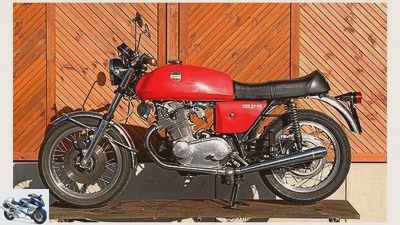
Schermer
The Laverda 750 (type 750 SF2).
My grumbling on the previous pages wasn’t off-putting enough? Then you should be able to answer the following questions with a clear “yes” before you get involved with a Laverda 750:
- You are aware that the appearance, character and sound of Laverda motors are fundamentally different from those of other brands?
- They also know that the driving behavior of a Laverda 750 differs significantly from comparable machines of the time (Ducati 750 GT, Moto Guzzi V7 Sport, Le Mans or even 850 T3)?
- You have also noticed that a Laverda needs a lot of affection, much more than a Honda CB 750 Four, Kawasaki Z 900, Suzuki GS 750 or even a Honda Gold Wing? (Not quite as much as a Ducati 750 GT or a vertical shaft Desmo, however!).
- You also don’t mind that you need a lot of strength to drive a Laverda 750? It starts when you jack it up and down and it doesn’t stop when you push it around…
- You can’t do anything with today’s motorcycles for whatever reason?
- You want a real motorbike that demands respect from you – but which gives you a particularly intense driving experience?
And, the thumb always points upwards? Great, then you are really ready for a Laverda twin. Even as a woman, although the advertising at the time advertised a Laverda as the “men’s motorcycle” par excellence. Because: Women can also ride a motorcycle, pull a stiff clutch, shift right and brake left!
The only question is where to buy? It’s hard to say, because the market doesn’t have much to offer, at least for the 750s. There are no inexpensive Laverdas in Italy either. On the contrary, most of what is offered there is usually quite a botch. So all that remains is to get in touch with Laverda clubs, study classifieds and maybe even post a search advertisement.
Data (Laverda 750 SF2)
Engine:
Air-cooled two-cylinder four-stroke in-line engine, one overhead camshaft, two valves per cylinder, bore / stroke 80 mm x 74 mm, displacement 744 cm³, output 47 kW (65 HP) at 7000 rpm
Power transmission:
Multi-disc oil bath clutch, five-speed gearbox, chain drive
Landing gear:
Steel tube bridge frame, telescopic fork, Ø 38 mm, two-arm swing arm, two spring struts, spoked wheels, tires 3.25 H 18 at the front, 4.00 H 18 at the rear, double disc brake at the front, Ø 280 mm, drum brake at the rear
Measurements and weight:
Wheelbase 1465 mm, weight with a full tank 236 kg
Mileage:
Top speed 185 km / h
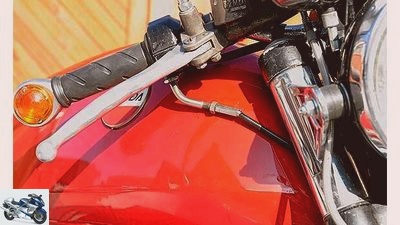
Schermer
Swivel the handlebar all the way to the right and left as far as it will go. Sufficient space must be left between the fittings and the tank. It is missing here. The cause is often a bent steering stop as a result of a fall.
Facelift
- 1966: Presentation of the prototype with 650 cm³ at the motor show in London.
- 1968: Sales designation Laverda 650. Power 50 hp at 6800 rpm. 52 pieces were built. Early specimens without frame homologation number, later specimens with homologation number DGM.5932.OM. Domed valve adjustment caps. Ceriani fork, Ø 35 mm. Ribbed Grimeca drum brakes: front duplex, Ø 230 mm, rear simplex, Ø 200 mm. Square mudguards made of stainless steel. Wide tank with luggage rack and knee cushion, side cover made of sheet metal, Smith instruments with Laverda logo, speedometer up to 190 km / h. 32 Ah battery. The rear of the muffler is cut at an angle (“salami pots”). Elongated Bosch headlight, Ø 155 mm with push-in ignition key.
- Late 1968: Laverda 750 (approx. 300 units built). 52 hp at 6700 rpm. Larger cylinder bore (80 mm instead of 74 mm), flat (GT) pistons, compression 7.7: 1. Flat bench.
- 1969: Laverda 750 (approx. 450 pieces), no changes. New model Laverda 750 S (approx. 200 pieces) with 60 hp at 6900 rpm. Transitional model with an old frame, modern fork and Smith instruments. Tank with screw cap but without a luggage rack.
- 1970: Laverda 750 S (approx. 1100 pieces), new “S” frame with narrower upper parts, slimmer tank (17.5 l), sporty seat, Ceriani fork with bellows. Modified primary chain tensioner. Motor housing reinforced with a rib on the cylinder base at the rear left. Silencer with homologation “DGM 5933 S” and rubber bearings. Late systems had an interference tube at the front. New Grimeca brakes: front 230 mm duplex with short brake anchor and three round openings, rear 200 mm simplex without ribs on the anchor plate. Laverda 750 GT (approx. 650 pieces): high handlebar, otherwise like 750 from the 1969 vintage, from chassis no. 2833 with S-frame and S-brake.
- 1971: Laverda 750 SF (approx. 2800 pieces), 60 hp at 6900 rpm. Laverda own duplex brakes front and rear. Revised SF frame, new fork with bare stanchions, brake pedal over left footrest. Old tank with knee cushions and snap lock. Double bench with sheet metal body. 1st gear has a shorter gear ratio, high S pistons, engine housing reinforced with a rib on the cylinder base at the rear left. Laverda 750 GT (approx. 500 pieces): old disguised fork, S-frame, new Grimeca drum brakes.
- 1972: Laverda 750 SF (approx. 3300 pieces), instruments from Nippon Denso, new slim tank with snap lock, double seat bench with plastic base, first crankshaft bearing on the left of the primary drive with roller bearings instead of ball bearings. Laverda 750 GT (approx. 1000 units): 52 hp at 6900 rpm. From chassis no. 4xxx with frame, brakes and fork of the SF type. Lightened SF crankshaft, flat GT pistons, two 30mm Dellorto carburettors with air filters.
- 1973: Laverda 750 SF1 (approx. 1200 pieces), 65 HP at 7000 / min, larger valves, 36 mm Dellorto carburetor, exhaust with larger manifolds and a collector below the engine that quickly attaches. Long cone silencer. Modified frame, smaller battery, CEV headlights, Lucas switch on the handlebar, connections of the wiring harness on the right under the tank (previously in the headlight), from the end of 1973 under the air filter.
- 1974: Laverda 750 SF2 (approx. 1700 pieces), 65 HP at 7000 rpm, modified camshaft, silencer with short cone. Instruments and handlebar switches from Nippon Denso, electrics from Bosch. Brembo disc brakes in front (single or double), rear drum like SF1. Late models with 16 instead of 15 cooling fins on the cylinder head and 13 instead of 14 fins on the cylinders.
- 1975: Laverda 750 SF2 (approx. 800 pieces), 38er Ceriani fork from the three-cylinder 1000 C3.Laverda 750 GTL (approx: 300 pieces): Motor of the SF with 52 HP at 6900 rpm, modified SF1 frame, Marzocchi -Fork with bellows, brakes of the SF1 and a modified tank shape, to which the side covers nestle smoothly. Gear shift on the left, brake on the right. Foldable bench with storage compartment. SF2 exhaust with Conti silencers.
- 1976: Laverda 750 SF2 (approx. 300 pieces) and GTL (approx. 300 pieces), no changes. Laverda 750 SF3 (approx. 500 pieces): 65 HP at 7000 rpm. Needle bearing in rear swing arm. Three Brembo disc brakes (Ø 280 mm), cast wheels and modern double seat bench with plastic rump.
- 1977: Laverda SF1: About 100 to 300 copies are assembled from spare parts.
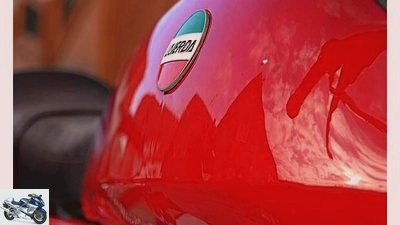
Schermer
Look closely: on this Laverda you can see a lacquer nose, also known as “Trieler”, under the tank emblem. It is an unmistakable sign of bad repainting. Take this into account when negotiating prices!
Specialists
Laverda paradise
Andy Wagner, 78467 Constance,
www.laverda-paradies.de
Orange Cycle Team (OCT)
53881 Dom-Esch,
www. octeam.de
Cycle Doctor Thomas Eatman,
88171 Weiler-Simmerberg,
Tel. 08387/924154
Sport Connection
64658 Fuerth / Odenwald,
www.sport-connection.de
Importers
The fact that a relationship of trust between the factory and the importer, the importer and the dealer and from the latter to the customer has never really been able to develop is mainly due to the checkered history of the German Laverda agencies. Here is an overview of all
Importers:
1969 to 1970: Georg Suck, Hamburg
1971: Standex, Alzenau
1972 to 1974: Edmund Buhler, Stuttgart
1975 to 1978: Detlev Louis, Hamburg
1979 to 1980: Zweirad Roth, Hammelbach / Odenwald
1981 to 1992: Witt, Cologne
Scene / forums
www. forum.laverda-register.de
www.laverdaforum.com
www.italobikes.com
www.laverdafreunde.at
www.laverdacorse.it
Related articles
-
Purchase advice Suzuki Intruder C-M 800
bilski-fotografie.de 10 pictures bilski-fotografie.de 1/10 Suzuki Intruder C / M 800 in used purchase. Suzuki 2/10 Elongated fenders, running boards and…
-
Laverda specialists Orange Cycle Team
Siemer 24 pictures Siemer 1/24 Siemer 2/24 Siemer 3/24 Siemer 4/24 Siemer 5/24 Siemer 6/24 Siemer 7/24 Siemer 8/24 Siemer 9/24 Siemer 10/24 Siemer 11/24…
-
Laverda Bimota – merger of two motorcycles
Fred Siemer 17th pictures Fred Siemer 1/17 An East Frisian collector appreciates the three-cylinder Laverda just as much as special European chassis….
-
archive 36 pictures archive 1/36 Buying advice: What to look for when buying a large-displacement Moto Guzzi twin from the 70s and 80s. archive 2/36…
-
Purchase advice Kreidler Florett RS
Bilski 41 pictures Bilski 1/41 Uli Steeb identified the bearing of the sprocket carrier as a frequent damage. Then a new industrial bearing (6004) must…
-
Purchase advice – Nine current superbikes in a bargain check
fact / sorcerer11 – Fotolia 37 pictures fact 1/37 Sports fans were supplied with fresh material in 2015 – predecessors have to be removed and innovations…
-
Motorcycle helmet purchase advice: What to look out for when buying a helmet
MIPS 10 pictures MIPS 1/10 Researchers and studies have linked severe brain injuries, as well as minor injuries such as concussions, to rotational…
-
Motorcycle helmets: test, purchase advice, ECE standard, communication
Herder 14th pictures Herder 1/14 Jorg Lohse trying in vain to mount a wind deflector on the X-lite. Can you test harder? no! Herder 2/14 The Schuberth S1…
-
counselor Used purchase Used advice Honda CB 500 Used advice Honda CB 500 From the same mould Honda’s new model in the inexpensive entry-level class had…
-
Second-hand advice Kawasaki W 650
Gargolov counselor Used purchase Second-hand advice Kawasaki W 650 Second-hand advice Kawasaki W 650 For nostalgics The start of the Kawasaki W 650 was…